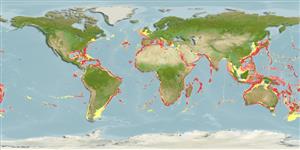Common names from other countries
Environment: milieu / climate zone / depth range / distribution range
Ecologia
Bentopelágico; intervalo de profundidade 60 - 1300 m (Ref. 97594), usually 250 - 750 m (Ref. 409). Tropical; ? - 14°C (Ref. 434), preferred 20°C (Ref. 107945); 55°N - 55°S, 180°W - 180°E
Atlantic, the Mediterranean and Indo-Pacific. Tropical to temperate.
Length at first maturity / Tamanho / Peso / Idade
Maturity: Lm 3.7, range 3 - 4.414 cm Max length : 17.0 cm TL macho/indeterminado; (Ref. 104052); 22.5 cm TL (female); Peso máx. publicado: 45.90 g (Ref. 126095); Peso máx. publicado: 45.90 g; Idade máx. registada: 8 anos (Ref. 80203)
Deep-water benthopelagic shrimp (Ref. 114287). Common total length: 12 to 16 cm. Minimum common depth from Ref. 8. Usually caught on muddy and sandy bottoms of continental slopes (Ref. 434). Lives on bottom mud (Ref. 8); also on sandy bottoms. Moves to midwater at night (Ref. 409). Carnivorous, feeds mainly on euphausiids and other species of crustaceans, i.e., mainly Natantia sp. (Ref. 434). Has a highly diversified diet (Refs. 97770, 105137), preying on pelagic, benthic and benthopelagic organisms (Ref. 105137); mainly forages on crustaceans and fish. Also scavenges upon carcasses of fish and cephalopods on the bottom (Ref. 97770). Exhibits cannibalism. Values of δ15N ranges from 6.68 and 7.96 in females, and 7.05 and 8.26 in males, with females having higher δ15N with increasing size (Ref. 105135).
Life cycle and mating behavior
Maturidade | Reprodução | Desova | Ovos | Fecundidade | Larvas
Spawning occurs during spring to summer. Females have a life span of 7-8 years while males live for 5-6 years.
Pérez Farfante, I. and B. Kensley. 1997. (Ref. 75620)
Categoria na Lista Vermelha da IUCN (Ref. 130435)
Categoria CITES (Ref. 108899)
Not Evaluated
Not Evaluated
Utilização humana
Pescarias: espécies comerciais
FAO - pescarias: landings | FishSource | Sea Around Us
Ferramentas
Fontes da internet
Estimates based on models
Preferred temperature
(Ref.
115969): 5.9 - 15.7, mean 10 (based on 1552 cells).
Resiliência
Elevada, tempo mínimo de duplicação da população menor que 15 meses (K=0.37-0.96; tm=1.5; tmax=8).
Prior r = 0.77, 95% CL = 0.51 - 1.16, Based on 4 full stock assessments.
Vulnerabilidade
Low vulnerability (10 of 100).
